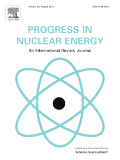
Progress in Nuclear Energy
Scope & Guideline
Exploring innovations in nuclear technology and safety.
Introduction
Aims and Scopes
- Nuclear Reactor Design and Safety:
Focuses on the design principles of various types of nuclear reactors, including small modular reactors and advanced reactor systems, emphasizing safety protocols and risk assessment methodologies. - Thermal-Hydraulic Analysis:
Investigates the thermal-hydraulic behaviors within nuclear systems, including the performance of cooling systems, heat exchangers, and the dynamics of two-phase flow under various operational conditions. - Radiation Shielding and Materials:
Explores innovative materials and composites for radiation shielding, including studies on their mechanical and thermal properties, as well as their performance in nuclear environments. - Nuclear Fuel Cycle and Waste Management:
Covers topics related to the nuclear fuel cycle, including fuel fabrication, spent fuel management, and waste disposal strategies, highlighting advancements in recycling and waste minimization. - Neutronics and Reactor Physics:
Addresses the fundamentals of neutron transport, criticality safety, and reactor kinetics, providing insights into the behavior of nuclear systems under various operational scenarios. - Artificial Intelligence and Machine Learning Applications:
Examines the integration of AI and machine learning techniques in nuclear energy systems for predictive maintenance, fault diagnosis, and optimization of reactor operations. - Environmental and Societal Impact Studies:
Analyzes the environmental consequences of nuclear energy production, including public perception, regulatory challenges, and the socio-economic implications of nuclear technology.
Trending and Emerging
- Advanced Reactor Concepts:
There is a growing emphasis on innovative reactor designs, such as molten salt reactors and high-temperature gas-cooled reactors, which promise enhanced safety and efficiency. - Machine Learning and Digital Twins:
The application of machine learning techniques and the concept of digital twins for real-time monitoring, predictive maintenance, and optimization of nuclear systems are rapidly emerging as critical areas of research. - Sustainability and Environmental Impact Assessments:
Research is increasingly focused on the environmental impacts of nuclear energy, including lifecycle assessments and the role of nuclear energy in achieving carbon neutrality. - Accident Management and Safety Enhancements:
Emerging themes include advanced methodologies for accident management, safety analysis, and the development of passive safety systems that improve the resilience of nuclear facilities. - Hybrid Energy Systems:
Studies exploring the integration of nuclear energy with renewable sources, such as solar and wind, to create hybrid energy systems are gaining attention as a means to enhance energy security and sustainability.
Declining or Waning
- Traditional Thermal Reactor Technologies:
Research on conventional thermal reactors has decreased as focus shifts toward advanced and innovative reactor designs such as fast reactors and small modular reactors. - Single-Discipline Studies:
There is a noticeable trend away from isolated studies that focus on a single discipline (e.g., purely thermal-hydraulic or purely neutronics) towards more integrated, multidisciplinary approaches that combine various aspects of nuclear technology. - Conventional Radiation Shielding Materials:
The exploration of traditional shielding materials is declining in favor of novel composites and hybrid materials that offer improved performance and environmental benefits. - Historical Case Studies:
Research focused on historical nuclear incidents and case studies is becoming less frequent, as current studies prioritize predictive modeling and real-time safety assessments. - Basic Neutronics Calculations:
The frequency of basic neutronics calculations is waning as researchers increasingly employ advanced simulation tools and integrated approaches that combine neutronics with thermal-hydraulics.
Similar Journals

Plasma and Fusion Research
Pioneering Insights into the Future of Energy ProductionPlasma and Fusion Research is a pivotal journal within the realm of plasma science and nuclear fusion, published by the Japan Society of Plasma Science and Nuclear Fusion Research. With an ISSN of 1880-6821, this journal serves as a vital platform for disseminating significant research findings and advancements from Japan and around the globe. Operating since 2006, it has steadily contributed to the field, reflected in its recognition as a Q3 journal in Condensed Matter Physics for the year 2023 and its ranking of #383 out of 434 in the Scopus categories, placing it in the 11th percentile. Although it currently does not offer open access, the journal's commitment to quality research makes it essential reading for researchers, professionals, and students keen on exploring the complexities of plasma dynamics, fusion technology, and their applications in energy production. Situated in Nagoya, Japan, the journal fosters a collaborative environment aimed at pushing the boundaries of knowledge in plasma physics and enhancing the understanding of fusion processes.

Nuclear Physics and Atomic Energy
Advancing knowledge in nuclear physics and energy.Nuclear Physics and Atomic Energy is a reputable open-access journal that focuses on the fields of nuclear physics and high-energy physics, providing a forum for researchers, professionals, and students to share their findings and advancements. Published by the Institute of Nuclear Research, National Academy of Sciences of Ukraine, this journal has been committed to disseminating knowledge since its inception in 2006, ensuring that scientific advancements remain accessible to a global audience. With an ISSN of 1818-331X and an E-ISSN of 2074-0565, the journal features a diverse array of articles that span the continued exploration and application of nuclear phenomena. Although currently categorized in the Q4 quartile for Nuclear and High Energy Physics in 2023, the journal is steadily working towards increasing its impact and engagement within the academic community. With a Scopus rank of #74 out of 87 in its category, it serves as a valuable resource for advancing crucial research in a vital scientific area. Researchers are encouraged to contribute their innovative studies to foster collaboration and knowledge sharing in this dynamic field.
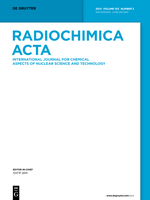
RADIOCHIMICA ACTA
Fostering Innovation in the Study of Radioactive InteractionsRADIOCHIMICA ACTA, published by Walter de Gruyter GmbH, is a leading journal in the field of Physical and Theoretical Chemistry, with a storied history dating back to 1962. Based in Berlin, Germany, this esteemed journal serves as a vital platform for researchers, professionals, and students interested in the intricate interactions between radioactivity and chemical processes. With an impressive *Scopus rank* of 125 out of 189 and a *Category Quartile* ranking of Q3 for 2023, it is recognized for contributing significant findings to the scientific community. Although it currently does not provide open access options, RADIOCHIMICA ACTA continues to enrich the field through its commitment to disseminating high-quality research and critical reviews. As it converges toward its milestone year of 2024, the journal remains an essential resource for advancing knowledge in radioch Chemistry, shaping the future of theoretical explorations and practical applications alike.
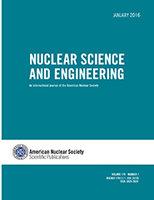
NUCLEAR SCIENCE AND ENGINEERING
Connecting Academia and Industry in Nuclear ResearchNUCLEAR SCIENCE AND ENGINEERING, published by Taylor & Francis Inc, is a leading journal in the field of nuclear energy and engineering, providing a vital platform for disseminating cutting-edge research and advancements from both academia and industry. With an ISSN of 0029-5639 and an E-ISSN of 1943-748X, the journal boasts a notable impact factor and is categorized in the Q2 quartile for 2023, reflecting its influence and quality in the field. Covering a comprehensive scope from the inception of nuclear technology in 1969 to contemporary advancements forecasted for 2024, it ranks #38 out of 77 in the Scopus Energy – Nuclear Energy and Engineering category, placing it in the 51st percentile. Although the journal is not open access, it remains essential for researchers, professionals, and students seeking to stay abreast of the latest developments and innovations in nuclear science. Located in the heart of Philadelphia, NUCLEAR SCIENCE AND ENGINEERING contributes significantly to the advancement of nuclear engineering knowledge and practice, making it a crucial resource for anyone involved in this dynamic field.

JOURNAL OF RADIOANALYTICAL AND NUCLEAR CHEMISTRY
Illuminating the path to understanding radioactive materials.JOURNAL OF RADIOANALYTICAL AND NUCLEAR CHEMISTRY, published by Springer, serves as a vital platform for the dissemination of research in the fields of analytical chemistry, nuclear science, and radiochemistry. With an ISSN of 0236-5731 and an E-ISSN of 1588-2780, this journal has been a beacon of innovation and scholarly communication since its inception, transitioning from converged years of 1977-1979 to its current continuity from 1984 to 2024. Positioned in the Q3 category for analytical chemistry and other related fields such as health, toxicology, and nuclear engineering, it boasts significant standings in the Scopus rankings, reflecting its relevance and impact within these disciplines. The journal emphasizes open access, encouraging broader accessibility to quality research, which is critical for students, professionals, and ongoing global scientific discussions. As a leader in its domain, the JOURNAL OF RADIOANALYTICAL AND NUCLEAR CHEMISTRY is committed to advancing the understanding of radioactive materials, environmental safety, and health applications, ensuring its readers remain at the forefront of emerging trends and discoveries.

REVIEWS IN CHEMICAL ENGINEERING
Unveiling Cutting-edge Developments in the Field.REVIEWS IN CHEMICAL ENGINEERING, published by Walter de Gruyter GmbH, is a premier journal that delivers cutting-edge insights and comprehensive reviews in the field of chemical engineering. Established as an eminent resource since 1982, this journal is committed to advancing knowledge and fostering innovation in various domains of chemical engineering, including process design, materials, and environmental considerations. With an impressive Q1 ranking in the 2023 Scopus category for Chemical Engineering and a commendable 20th position out of 273 journals, it is recognized for its rigorous peer-review process and high-impact contributions. Although it operates under a subscription model, the journal remains a vital platform for researchers and professionals aiming to stay at the forefront of technological advancements and scholarly discourse in chemical engineering. With a focus on interdisciplinary applications and real-world relevance, REVIEWS IN CHEMICAL ENGINEERING is an indispensable resource for academics, industry professionals, and students dedicated to excellence in this field.

ATOMIC ENERGY
Illuminating the path of innovation in atomic science.ATOMIC ENERGY is a distinguished journal published by SPRINGER, focusing on pivotal advancements and research within the field of Nuclear Energy and Engineering. With an ISSN of 1063-4258 and an E-ISSN of 1573-8205, this journal has been a critical resource since its inception in 1956, serving both historic and contemporary scientific inquiries into nuclear technologies. Currently positioned in Q3 of the Nuclear Energy and Engineering category, ATOMIC ENERGY ranks 49 out of 77 in Scopus, representing a percentile of 37%, highlighting its relevance in the research community. While it is not an open access journal, it continues to draw a diverse readership eager to engage with the latest findings and innovations in nuclear science. The journal’s objectives include fostering collaborative research, sharing expertise, and addressing contemporary challenges in nuclear energy. As such, ATOMIC ENERGY remains an essential platform for researchers, professionals, and students alike, contributing significantly to the ongoing dialogue in the field.
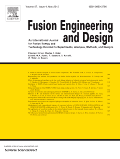
FUSION ENGINEERING AND DESIGN
Driving High-Impact Discoveries in Energy Solutions.FUSION ENGINEERING AND DESIGN is a premier scientific journal published by Elsevier Science SA, dedicated to advancing the field of fusion engineering, materials science, and related disciplines. Established in 1985 and running through 2024, this journal features cutting-edge research that spans multiple categories, including Civil and Structural Engineering, Mechanical Engineering, Materials Science, and Nuclear Energy and Engineering, holding a notable Q2 quartile ranking in each field as of 2023. Catering to a global audience of researchers and professionals, FUSION ENGINEERING AND DESIGN emphasizes the importance of interdisciplinary collaboration and innovative technology in tackling the complex challenges associated with fusion energy. Although it does not offer Open Access, the journal remains an essential resource for those seeking to stay abreast of developments that could shape the future of energy solutions and engineering methodologies. With a dedicated editorial board and a commitment to high-impact publication, this journal serves as a vital platform for disseminating transformative ideas and driving forward the scientific dialogue in fusion engineering.
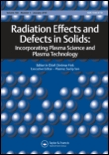
Radiation Effects and Defects in Solids
Bridging Theory and Application in Radiation ResearchRadiation Effects and Defects in Solids is a prestigious academic journal published by TAYLOR & FRANCIS LTD that has been at the forefront of research related to the impacts of radiation on various solid materials since its inception in 1989. With an ISSN of 1042-0150 and an E-ISSN of 1029-4953, this journal serves as an essential resource for researchers and professionals in the fields of Condensed Matter Physics, Materials Science, and Nuclear and High Energy Physics. Despite its current categorization in the Q4 quartile across these disciplines, Radiation Effects and Defects in Solids remains critical for advancing knowledge of material responses to radiation, which is vital for applications in nuclear energy, space exploration, and radiation therapy. The journal publishes original research articles, reviews, and letters that provide insights into material properties, radiation dosimetry, and defect structures, fostering collaboration and innovation within the scientific community. As the field evolves, Radiation Effects and Defects in Solids continues to play a significant role in disseminating valuable research findings and keeping pace with emerging trends in materials science and radiation physics.

Science and Technology of Nuclear Installations
Advancing Nuclear Innovation for a Sustainable FutureScience and Technology of Nuclear Installations, published by HINDAWI LTD, is an esteemed scholarly journal specializing in the dynamic field of nuclear energy and engineering, with an ISSN of 1687-6075 and an E-ISSN of 1687-6083. Since transitioning to an Open Access model in 2007, the journal has significantly contributed to the dissemination of innovative research and practical applications in nuclear technology, attracting a global audience from both academia and industry. Based in Egypt, this prominent journal serves as a vital platform for researchers seeking to explore advanced methodologies, cutting-edge technologies, and the sustainable development of nuclear installations. Achieving a commendable Q2 category ranking in Nuclear Energy and Engineering and positioning at #35/77 in Scopus rankings (55th percentile) underscores its influential presence within the scientific community. With a publication horizon extending from 2008 to 2024, the journal remains committed to fostering collaboration and innovation in nuclear science, making it an invaluable resource for researchers, professionals, and students alike.